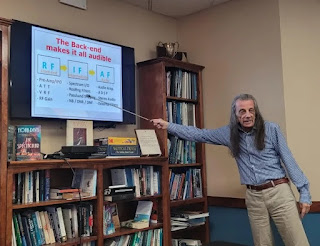The final weekend of February brings us a number of disparate radio sport events.
The goal for this 5-contest weekend was to run the events using QRP power where practical.
While there were numerous other events that weekend, the WQ6X agenda included:
- [X] - CQ Worldwide 160-Meter Ssb Contest (QRP)
- [X] - North American QSO Party (NAQP) RTTY Contest (QRP)
- [X] - The South Carolina QSO Party (SCQP) on Saturday (QRP)
- [X] - The North Carolina QSO Party (NCQP) on Sunday (QRP)
- [X] - World Wide Patagonia DX Contest (LP)
Because one of the main goals was to run 160 meters, the choice was made to run all
the events from the WA6TQT superstation in Anza; STN-1 for 160-meters and STN-2
for NAQP and the QSO parties while WA6TQT runs STN-1.
Making the CQ-160 Ssb GiG work running QRP is a WaY different challenge than running QRP-Cw on 160-meters. Internet dropouts on my remote end of the connection, make it even more tricky, altho pre-recording the 4 voice keyer memories helped navigate the internet-dropout situations.
When it was all over, overall, I was satisfied with the whopping 13-QSOs that actually made
it to the CQ-160 log - that contribution to a 5-contest weekend was not unimportant.
After several hours sleep, it was time to upgrade the K3/0-Mini arrangement by including a very
classic RiGExpert PLUS to modulate AFSK RTTY tones into the microphone jack of the K3/0-Mini.
Because we are running RTTY from the CLIENT-side of the internet connection, the remote radio
is CAT-controlled locally thru Virtual-Com1 port on the front of the RRC-1258 internet interface box.
While everything is controlled locally, it is crucial to realize that the radio we are controlling
requires 2 working internet connections, as well as properly functional hardware and software
on both ends. While getting everything setup correctly can be tricky, once the components are
all in synch, it's almost as GooD as actually being in the Anza op-chair.
During the 1st-two hours of the NAP GiG, I couldn't find the radiosport "Zen place" I always
endeavor to slip into. In order to put some of the use op-time to effective use, the switch was
made to Cw, looking for SC stations in the South Carolina QSO Party - at least, I can say I was
there - on Sunday, we switch to hunting North Carolinians.
Eventually WQ6X found the radiosport-groove, running frequencies in 10m, 15m & 20m, with some judicious S&P hunting in between. While sometimes difficult to hold a run frequency running QRP, once in the clear, calling stations dutifully lined-up for their chance to work the illusive WQ6X.
Upper band condx. were not as plentiful as the previous WPX RTTY contest, returning
20-meters to its rightful status of being the PREMIERE RTTY band.
For 20 (and eventually) 40 meters, running stacked Yagi's pointing in different directions yielded
a lot of azimuth coverage. To peak a signal, once the callsign is determined, a switch can be made
to the yagi-stack favoring that azimuth direction, on the basis that the transmit signal will also be slightly enhanced. For 80-meters, a 4-Square phased vertical array give us N-W, N-E, S-E & S-W directions with a more-or-less 90-degree beam-width. Gain as well as front-to-back is what you get when running four properly-phased ~66-foot vertical elements. In phased configurations, previously-noisy vertical elements become even more lower-angle and extremely quiet (relatively speaking).
By the time I finally got into the groove of switching between 40 & 80 meters, we were down
to the final 15-minutes of the NAQP RTTY GiG. (Many operators choose the final-2 contest
hours as their required 2-hour off-time period, resulting in a frustrating QSO-rate reduction.
Shortly after the contest I met up w/ragchew friends on our regular 3.853 frequency as part
of our Monday-Thursday-Saturday meeting of the Redwood Radio Roundtable (w/100-ft trees
in all directions). We welcome visitors to join us on any of those evenings 1030pm PDT.
Afterward the Roundtable, a quick run on 160-meters put less-than a handful of QSOs
in the log, effectively ending the CQ 160-Ssb contest for WQ6X.
After a lengthy sleep it was time to go hunting for NC (North Carolina) stations. Because I tend
to run these events "assisted" (i.e. using internet spots), it is easier to find desirable QP stations,
altho incorrectly spotted stations are always an issue. Regardless of the spots, it is up to actually correctly copying the callsign that eventually puts each station in the log. Eventually, 32 QRP-QSOs made it into the WQ6X NCQP contest log.
What about YOU? DiD YOU participate in any of the above radiosport events?
Is WQ6X in YOUR LoG?









.Jpg)




.Jpg)




